Translate this page into:
Osteolytic Skull Lesions–Our Experience
Address for correspondence: Dr. B. V. Sandeep, Department of Neurosurgery, 6th Floor, U.N.B. Building, Nil Ratan Sircar Medical College and Hospital, 138, A J C Bose Road, Sealdah, Kolkata, West Bengal - 700 014, West Bengal, India. E-mail: sandybv200@gmail.com
This is an open access article distributed under the terms of the Creative Commons Attribution-NonCommercial-ShareAlike 3.0 License, which allows others to remix, tweak, and build upon the work non-commercially, as long as the author is credited and the new creations are licensed under the identical terms.
This article was originally published by Medknow Publications & Media Pvt Ltd and was migrated to Scientific Scholar after the change of Publisher.
Abstract
Objective:
To present an overview of varied clinical presentations, investigations and treatment options for Osteolytic skull lesions.
Study Design:
It is a prospective study.
Materials and Methods:
We conducted this study from January 2013 to December 2015 in the Department of Neurosurgery, Nil Ratan Sircar Medical College and Hospital, Kolkata. During this period, 14 patients presented with osteolytic skull lesions through the outpatient department. All patients were thoroughly investigated with appropriate hematological and radiological investigations and treated following admission, and surgery was performed in the Neurosurgery Department. All were followed regularly in OPD.
Results:
Total 14 patients were included in the study. Amongst these 7 were male and 7 female. Age group of patients ranged from 5 to 72 years. Of 14 cases, three cases had dermoid cyst, four cases had metastasis, and one each case had epidermoid cyst, intradiploic meningioma, benign cystic lesion, tuberculosis, histiocytosis X, hemangioma, and osteomyelitis. All underwent diagnostic/therapeutic procedures and referred for Radio or chemotherapy where indicated.
Conclusion:
All scalp/skull lesions need careful clinical correlation, appropriate radiological investigations to establish diagnosis and subject them to suitable treatment.
Keywords
Osteolytic skull lesion
skull lesions
skull tumors
INTRODUCTION
Osteolytic skull lesion is a rare entity among neurosurgical patients. It constitutes about 1% of all skull tumors. Differential diagnosis is broad which includes both benign and malignant lesions. Majority of these are benign. Lesions usually present as an enlarging hard or soft mass which may be painful or painless over the skull with or without tenderness. Lesions are broadly categorized into congenital, traumatic, inflammatory, and neoplastic lesions.[1]
In children and young adults, osteolytic skull lesions include epidermoid/dermoid, eosinophilic granuloma, encephaloceles, hemangioma, osteoblastoma, and aneurysmal bone cyst. In adults, metastasis and multiple myeloma are the most common diagnosis. In adults, a source for primary lesion should always be searched with the suspicion of metastasis. However in all age groups, surgical defects, fibrous dysplasias, sarcomas, lymphomas, intraosseous meningiomas, and intracranial tumor with erosion of skull are rare.[2]
MATERIALS AND METHODS
We conducted a prospective study from January 2013 to December 2015 in the Department of Neurosurgery, Nil Ratan Sircar Medical College and Hospital, Kolkata. During this period, 14 patients presented with osteolytic skull lesions through the outpatient patient. They were treated following admission, and surgery was performed in the Neurosurgery Department.
Inclusion criteria
Patients of all ages and both genders were included in the study.
RESULTS
Gender and age group
Age group range of the patients in this study was wide (5–72 years), and the lesions were of same incidence in both male and female [Tables 1 and 2].


Clinical features
Of 14 cases, eight cases presented with painless swelling. The rest six cases presented as a painful swelling which included cases with metastasis, osteomyelitis, and tuberculosis and a case of benign cystic lesion.
Operative procedure and treatment
Planning of surgery and incisions was taken depending on the site of lesion.
All patients underwent complete excision of lesion including involved bone whenever necessary. Cranioplasty for calvarial defect following surgery was done in seven cases.
Four cases of metastasis after excision of the lesion were referred to the chemoradiotherapy department for further evaluation and management. One case of the tubercular lesion had excision of the lesion followed by antitubercular therapy. One case of histiocytosis X after excision was referred to the hematology department for further management.
Histopathology
Of 14 cases, three cases had dermoid cyst, four cases had metastasis, and one each case had epidermoid cyst, intradiploic meningioma, benign cystic lesion, tuberculosis, histiocytosis X, hemangioma, and osteomyelitis [Table 3].
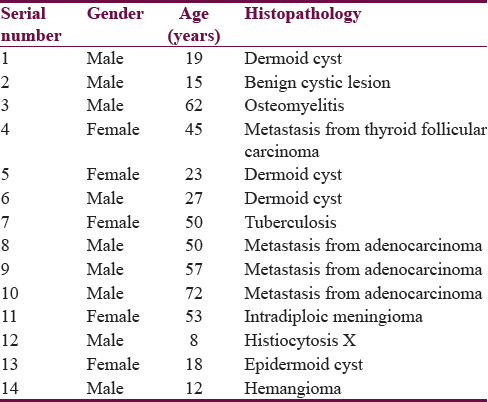
DISCUSSION
In a study by Anwar et al., 12 cases of osteolytic skull lesions were treated. Of these, three cases were each of tuberculosis and malignancies, two cases of midline benign lesions, and one each of posttraumatic, infection, and metastasis.[2]
In our study, 14 cases were treated which included three cases had dermoid cyst, four cases had metastasis, one each case had epidermoid cyst, intradiploic meningioma, benign cystic lesion, tuberculosis, histiocytosis X, hemangioma, and osteomyelitis.
Intracranial dermoid cysts are rare congenital lesions that account for 0.04%–0.7% of all intracranial tumors.[3] Dermoid cysts originate from embryonic ectodermal cells that are involved in the process of primary neurulation. Dermoid cysts primarily occur in intradural regions; however, rarely, interdural dermoid cysts have been reported. Although the posterior fossa is the most common location for dermoid cysts, a few intradural dermoid cysts originating from skull base have been reported. Extradural dermoid cysts are observed in the posterior fossa, diploe of anterior fontanelle, and orbital region in children and young adult.[4]
In our study, we encountered three cases of dermoid cysts, of which two patients were male and one was female patient. Of three cases, one case was involving occipital midline skull while the other two was involving the left frontal and right temporoparietal skull [Figure 1].
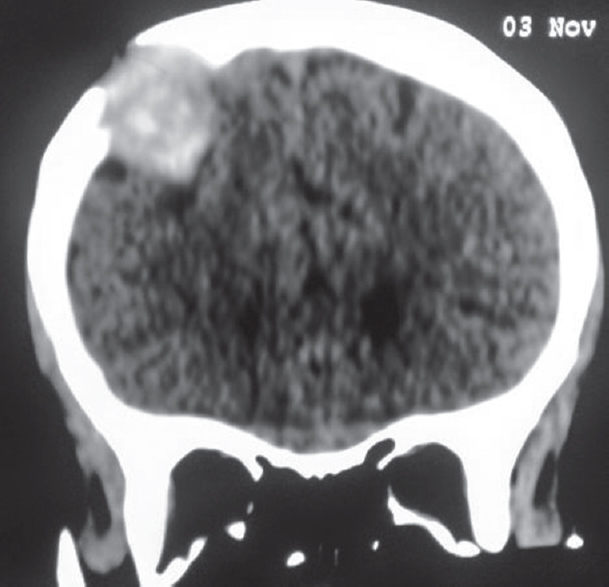
- Dermoid cyst over the left frontal bone
An 18-year-old female presented with painless occipital swelling for 6 months. On excision, the histopathological report suggested epidermoid cyst.
Metastatic tumors to the skull are rare and originate mostly from the lung, breast, or prostate.[5] Most metastatic skull lesions are asymptomatic.
Skull metastases from a well-differentiated thyroid carcinoma are very uncommon.[6] In our study, we had a 45-year-old female patient who had undergone thyroidectomy for follicular thyroid malignancy. She presented with a painful mass over the left frontal region, which on excision turned out to be metastasis from the follicular malignancy. We also encountered three male patients who presented with a painful skull lesion in the left frontal bone, occipital bone, and right temporal bone each. The lesion was excised and histopathological examination report stated metastasis from adenocarcinoma. The patient was referred to the chemoradiotherapy department for further evaluation and treatment [Figure 2].
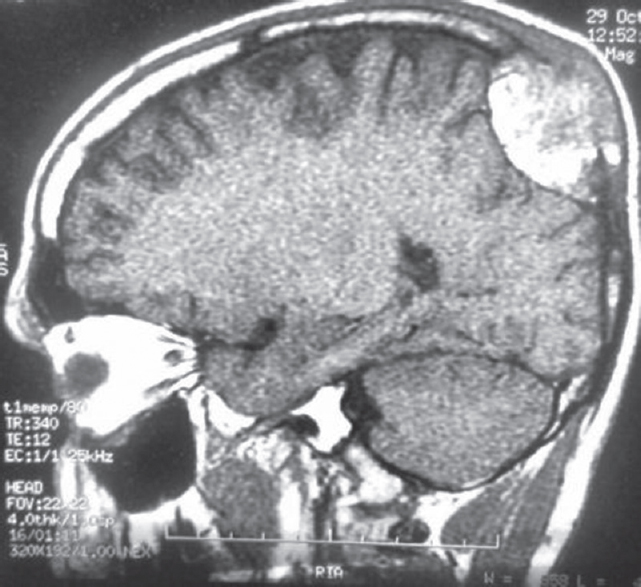
- Metastatic lesion involving occipital bone
Intraosseous hemangioma is a rare bone tumor accounting for 0.7%–1.0% of all bone tumors. It can occur in all ages but is most common in the fourth and fifth decades. It has a female preponderance (3:1).[7]
Intraosseous hemangiomas are usually seen in the vertebral column and rarely in the calvarium. Among the calvarial bones, the parietal bone is the most commonly involved, followed by the frontal bone and less frequently by the occipital and temporal bones.[8]
In our study, we had a 12-year-old male who presented with a painless swelling in the left parietal region which was excised and cranioplasty was done. Histopathology came out to be hemangioma.
The meningiomas that originate in the skull have been referred to as calvarial, intraosseus, or intradiploic. Winkler, in 1904, first described a meningioma originating in an extradural location. There are several reported cases of intraosseous intradiploic meningiomas although it is a rare entity. These tumors are mainly osteoblastic and few cases reported are osteolytic in nature. Of these, osteolytic type is more malignant than osteoblastic type of meningioma.[9]
In our study, we encountered a 53-year-old female patient referred a slowly growing painless lump in the right frontal region for 1 year and 6 months with a history of trauma. On excision, histopathological report was intradiploic meningioma [Figure 3].

- Intradiploic meningioma
Langerhans cell histiocytosis (LCH) is a rare condition that usually affects the pediatric population with an estimated annual incidence between 1 and 7 cases per million of the population. The incidence of LCH is greater in males than in females, with a male-to-female ratio of 2:1. LCH usually affects patients under 10 years of age, patients mainly present with localized bone pain, dyspnea, and malaise, and 75% have nondisseminated disease. The skull, femur, pelvis, and ribs are most commonly involved. With skull lesions, the orbit and the cranial base are frequently involved.[10]
In our study, we encountered an 8-year-old male with a history of head trauma 2 years back presenting with the left frontal painless swelling for 6 months. The lesion was involving the left frontal bone and roof of left orbit. The lesion was excised. Histopathological report suggested histiocytosis X. The patient was referred to the hematology department for further evaluation and treatment.
Reid et al.[11] reported the first case of calvarial tuberculosis in 1842. Before the advent of effective chemotherapy, calvarial tuberculosis was estimated to represent 0.2%–1.3% of all cases of skeletal tuberculosis. About 50% of the cases reported in the literature were in patients younger than 10 years, and 70%–90% were younger than 20 years. Increased vascularity, decreased resistance, and unmasking of a latent infection secondary to trauma are thought to be the predisposing factors. In most cases discussed in the literature, patients present with painless scalp swelling and at times a discharging sinus in the scalp.[1]
In our study, we encountered a 50-year-old female with no predisposing factors presenting with a painful swelling in the left temporal region with no evidence of discharging sinus. The lesion was excised and histopathology report suggested tuberculosis. The patient was started on antitubercular drugs [Figure 4].
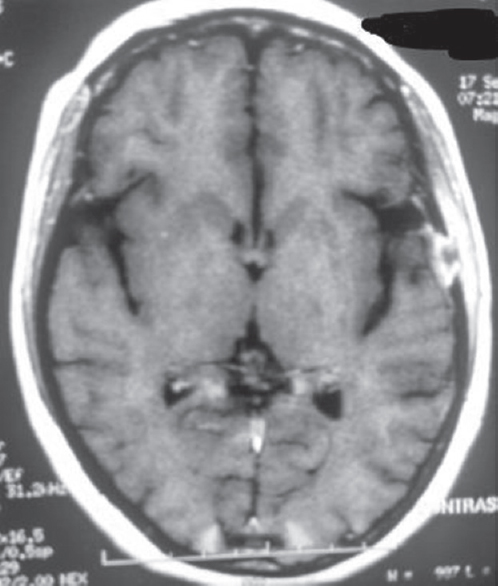
- Calvarial tuberculosis
Osteomyelitis was first described in 1852 by a French surgeon, Edouard Chassaignac. Pott, in 1778, postulated that osteomyelitis of the skull was caused by a bone contusion and extradural hemorrhage. However, it was not until 100 years later that Van Launelongue classified cases into two types, primary or hematogenous osteomyelitis and secondary or contiguous osteomyelitis. Etiology may result from trauma, bone surgery, bacteremia, or a contiguous infectious focus and is further influenced by diseases that affect the vascularity of bone, as well as by systemic diseases that produce an alteration of host defenses.[12]
In our study, we encountered a 62-year-old diabetic male patient with painful swelling in the left frontal region with discharging sinus for 3 months. The lesion was excised and culture report was suggestive of Staphylococcus aureus. Postoperative antibiotics were given in accordance to the culture report.
In our study, we encountered a 15-year-old male patient with a history of painless swelling in the right frontoparietal region for 2 years. On excision, the histopathological report suggested benign cystic swelling. We did not found a similar case during an extensive search of articles [Figure 5].
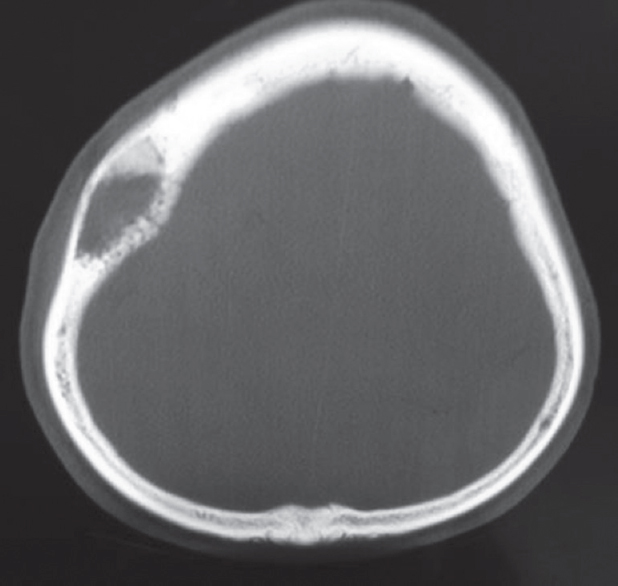
- Benign cystic lesion of the skull
CONCLUSION
Osteolytic skull lesions may be the presentation of many pathologies which may vary from infective, benign and malignant tumors. Proper clinical evaluation of the patient must be done including systemic examination for optimum treatment.
In the present study, patients with age more than 40 years had malignant lesions and infective lesions.
Surgical procedure was planned so that complete excision of the lesion must be done whenever possible. Further management of the patient mainly depends on the histopathological diagnosis.
Financial support and sponsorship
Nil.
Conflicts of interest
There are no conflicts of interest.
REFERENCES
- Imaging features of calvarial tuberculosis: A study of 42 cases. AJNR Am J Neuroradiol. 2004;25:409-14.
- [Google Scholar]
- Osteolytic skull lesions rare but important pathology in neurosurgical department. Pak J Neurol Surg. 2014;18:1.
- [Google Scholar]
- Craniocerebral epidermoids and dermoids. A review of 44 cases. Acta Neurochir (Wien). 1989;97:1-16.
- [Google Scholar]
- Extradural dermoid cyst located in the lateral sphenoid ridge. Brain Tumor Res Treat. 2014;2:39-42.
- [Google Scholar]
- Skull metastases: Clinical features, differential diagnosis, and review of the literature. Surg Neurol. 2003;60:219-25.
- [Google Scholar]
- Osteolytic skull metastasis with dural involvement from a papillary thyroid carcinoma. Coll Antropol. 2011;35:919-22.
- [Google Scholar]
- Cavernomas of the skull: Review of the literature 1975-2000. Neurosurg Rev. 2002;25:56-62.
- [Google Scholar]
- Primary intraosseous hemangioma in the frontal bone. Arch Plast Surg. 2013;40:283-5.
- [Google Scholar]
- Intradiploic meningioma of the skull: Case report and review of the literature. Neurocirugía. 1996;7:129-32.
- [Google Scholar]
- A rare case of langerhans cell histiocytosis of the skull in an adult: A systematic review. Rare Tumors. 2013;5:e38.
- [Google Scholar]
- Mediziniches Correspondenzblatt Bayerischer Erlangen. 1842;33






